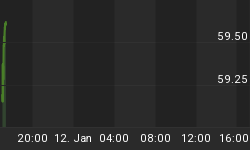Ben Had Just Reestablished Order
After tapering comments spooked the markets in May, Ben Bernanke spent weeks trying to jawbone the markets back into a calmer state. He was successful for the most part with the S&P 500 gaining 132 points off the June low.

Fed Tests Ideas In Print
If you want to read the Fed tea leaves, you have to keep an eye out for WSJ articles by Jon Hilsenrath, who is often referred to as the Fed's mouth piece. The Fed likes to send up policy trial balloons by feeding Mr. Hilsenrath, who in turn sees that the Fed's message makes its way to the front page of the Wall Street Journal.
Trial Balloon Falls Flat
The Fed floated a new trial balloon via Mr. Hilsenrath late Thursday night with this WSJ story. With the S&P futures down as much as 9 points Friday morning, it seems fair to say the Fed may have been better off keeping quiet.

Message Opens Deflation Door
One begins to wonder if the Fed is just a bunch of old, rich cronies with too much time on their hands. They can't leave well enough alone. Chairman Bernanke had successfully delivered the calming "rates will stay low for an extended period" message. The most recent WSJ story has once again planted a seed of economic doubt in the minds of market participants. Below are the key portions of the Hilsenrath story:
Officials will debate changes to the way the central bank describes its plans for the program and for short-term interest rates... The Fed has said that it intends to keep short-term interest rates near zero at least until the jobless rate drops to 6.5% or unless inflation rises to a 2.5% annualized rate. Mr. Bernanke suggested at his June press conference that the Fed might lower that 6.5% threshold for unemployment, which was set in September. Such a move would drive home to markets that short-term interest rates will be low for a long time.
There are other rhetorical steps the Fed might take in its forward guidance. One would be to match its publicly set upper bound for inflation with a new lower bound. The central bank has said it will raise short-term rates if inflation is seen as rising above the 2.5% target. It hasn't said what it would do if inflation drops much below the Fed's 2% medium-term objective. One option is to say that short-term rates won't rise if inflation falls below some threshold, perhaps 1.5%. Mr. Bernanke has already suggested as much. A formal assurance might amplify the Fed's message that rates are staying low and address the concern of some officials--notably St. Louis Fed President James Bullard--that the Fed needs to show resolve in preventing inflation from falling too low.
Markets Do Not Like Slowing Economic Growth
The less-politically correct interpretation of "show resolve in preventing inflation from falling too low" is that the Fed is concerned about deflation, or falling prices. Deflation is a symptom of a weak economy and weak demand for goods and services. If the Fed is worried about deflation, then it is fair to say they are worried about slowing economic growth. Markets do not like slowing economic growth.

Investment Implications
Chairman Bernanke would have had a better time with the markets in recent months if he would have acted more like King Greenspan, who did not allow mixed messages and clashing opinions among Fed governors into the public arena. Consensus is a nice concept, but the debate needs to be kept behind closed doors.

Fed Misstep A Catalyst?
As we outlined in detail on July 25, stocks are still the place to be relative to bonds (see chart below). As long as that remains the case, we will continue to favor risk-on (SPY) over risk-off (AGG), and U.S.-based leading sectors, such as financials (XLF), over foreign stocks (EFA). If conditions change, we are flexible and will adapt as needed. Today's Fed misstep could be the catalyst for change.
















